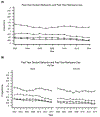Changes over time in marijuana use, deviant behavior and preference for risky behavior among US adolescents from 2002 to 2014: testing the moderating effect of gender and age
- PMID: 30461115
- PMCID: PMC6619500
- DOI: 10.1111/add.14506
Changes over time in marijuana use, deviant behavior and preference for risky behavior among US adolescents from 2002 to 2014: testing the moderating effect of gender and age
Abstract
Background and aims: Among adolescents, risk preference and deviant behaviors are associated with marijuana use, which exhibit substantial historical trends. We examined (1) trends, (2) effect modification by sex and age, (3) associations of marijuana use with deviant behaviors and risk preferences and (4) differences by sex, age and year.
Design: Adjusted logistic and relative risk regression models, using data from the 2002-14 National Survey on Drug Use and Health, annual cross-sectional surveys of US households.
Setting: United States.
Participants: A nationally representative sample of adolescents aged 12-17 years (n = 230 452).
Measurements: We estimated associations between past-year marijuana use [self-reported using computer-assisted personal interviewing/audio computer-assisted self-interviewing (CAPI/ACASI)], deviant behavior (i.e. selling drugs; stealing; attacking someone) and risk preference (i.e. getting a kick; testing oneself).
Findings: Marijuana use, deviant behaviors and risk preferences declined among adolescents from 2002 to 2014. There were no significant sex or age differences in the decline of marijuana use over time. There were sex [sold drugs: β = 0.90, 95% confidence interval (CI) = 0.75, 1.04] and age (attacked someone: β = 0.32, 95% CI = 0.22, 0.42) differences in the prevalence of deviant behaviors, and trends over time differed by sex and age for attacking someone.
Conclusions: While marijuana use, deviant behavior and risk preferences among US adolescents declined from 2002 to 2014, associations have remained stable, with marijuana use positively associated with deviant behaviors and risk preferences.
Keywords: Adolescents; deviance; gender differences; marijuana; risk preference; substance use; trends.
© 2018 Society for the Study of Addiction.
Conflict of interest statement
Figures




References
-
- Substance Abuse and Mental Health Services Administration. 2016. National Survey on Drug Use and Health: Detailed Tables. Rockville, MD: Center for Behavioral Health Statistics and Quality; 2017.
-
- Azofeifa A, Mattson ME, Schauer G, McAfee T, Grant A, Lyerla R. National Estimates of Marijuana Use and Related Indicators — National Survey on Drug Use and Health, United States, 2002–2014. MMWR Surveill Summ 2016;65(No. SS-11):1–25. Available from: https://www.cdc.gov/mmwr/volumes/65/ss/ss6511a1.htm. (Archived at http://www.webcitation.org/6yDa9fBen). - PubMed
-
- Weier M, Chan GCK, Quinn C, Hides L, Hall W. Cannabis use in 14 to 25 years old Australians 1998 to 2013. Brisbane, AU: Centre for Youth Substance Abuse Research; 2016. Available from: https://cysar.health.uq.edu.au/filething/get/1916/Cannabis%20technical%2.... (Archived at: http://www.webcitation.org/6yDcThJ3F).
-
- Arsaell A, Kort KG, Thoroddur B. Adolescent alcohol and cannabis use in Iceland 1995–2015. Drug Alcohol Rev. 2017. July 28 [Epub ahead of print]
Publication types
MeSH terms
Grants and funding
LinkOut - more resources
Full Text Sources
Medical
Miscellaneous

